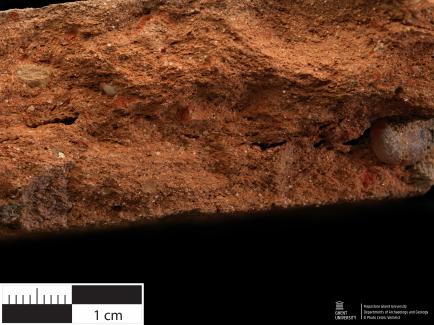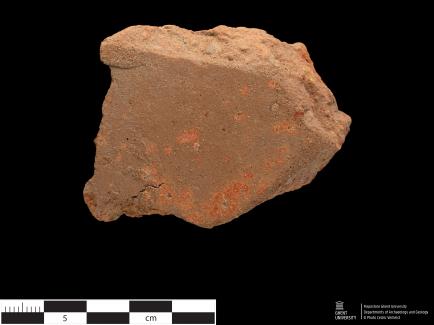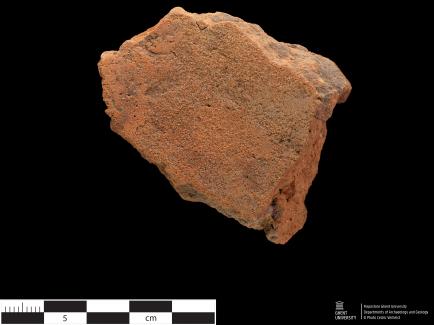Post Medieval - Ceramic building material (7.CBM.BE.0007)
Hand specimen pictures (macro & binocular)
Thin section pictures
Find location
- Category
- Ceramic building material (Post Medieval)
- Fabric name
- Chronology
- Post Medieval > Modern > 15th-17th century
- Dating method(-s)
- /
- Potters' mark
- No
- Additional information
- tile fragment
Find location
- Site type
- Pottery production
- Location
- Belgium; Oost-Vlaanderen; Stekene
- Site name
- Stekene, Dorpsstraat
- Excavation or Survey Team
- Archeologische Dienst Waasland (ADW)
- Additional contextual information
- xxx
- Slip
- No
- Slip color
- Glaze
- Yes
- Glaze type
- lead glaze
- Glaze color
- orange
- Glaze additives
- Additional information
- splashed glaze
- Surface color
- orange brown
- Surface texture
- Rough
- Fracture color
- orange brown
- Inclusions (non-plastics/tempering)
- abundancy of quartz; large quartz pebbles and granules; grog fragments (?), irregular red and beige inclusions (clay pellets ?)
- Matrix and voids
- vughs
- Diagnostic features
- Additional information
- Flepostore inventory nr.
- ARCH1.L1.B18
- Original inventory nr.
- A0034
- Collection
- Archaeological Department, Ghent University
- Type
- Covered thin section
- Comparable thin section(s)
- Matrix
-
Oxidised red fabric; brown (PPL), brown (XP).
Semi-heterogenous matrix, non-calcerous with no to low optical activity.
- ca. 40-60% - Inclusions
-
Quartz (++; mono+, poly-, cf: r-sr, fine to medium sand, ff: r-sa, very fine to fine sand, bimodal: posibly natural), sedimentary rock detritus (+-; quartz arenite, possible few micacious rock fragments), chert (+-), flint (+-), metamorphic rock detritus (+-; low and high grade from sedimentary parent rock), feldspars (+-; plagioclase), muscovite mica (+; el, cf & ff), glauconite (+; r, ff, redbrown body color), O/Fe (+), clay pellets/semi-plastics (+-; iron-rich), grog (+; sharp to clear boundaries, equant shape, discordant feature, various sizes and compositions: mainly oxidised fabrics, possible reduced grog fragment, few dried clay pellets, iron-rich and poor, various optical activities).
The coarse fraction consists of fine to medium sand, the fine fraction consists of very fine to fine sand. Grains are generally rounded to subangular. Overall the fabric is very poorly to poorly sorted and poorly orientated, close to singlespaced.
- ca. 30-40% - Voids
-
Many small planar voids and channels, few larger vughs, moderately well aligned, some infill at he edges.
- ca. 10-20% - Diagnostic features
- The fabric is characterized by a semi-heterogeneous oxidised matrix with no to low optical activity, moderate (high) porosity and intentional grog temper. Dominant quartz inclusions with frequent grog, muscovite mica, glauconite and opaques/iron oxides, common sedimentary and metamorphic rock detritus, chert, flint, feldspars and clay pellets/semi-plastics. Overall very poorly sorted fabric.
- Additional information
- Grog temper is a mixture of various compositions and textures. This indicates that the tempering material was not carefully selected, but rather a supply (of waste?) of various ceramics was crushed up and mixed into the same tempering raw material. Sand fraction might also be added, but some overlap in grain sizes and unclear distinction in minerals indicates rather a natural slight bimodality.
- Sample type
- Building material (decorative, construction)
- Inventory number
- 7.CBM.BE.0007
- Collection
- Archaeological Department, Ghent University
- Donating institute/person
- Onroerenderfgoeddepot Waasland, Erfpunt
- Host collection
- Onroerenderfgoeddepot Waasland, Erfpunt
- Other samples available
- Yes
- Sample collection method
- Archaeological Excavation
Cite this page as: Flepostore - https://flepostore.ugent.be/ceramics/7-cbm-be-0007
Last modified: 2024-04-29.





